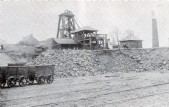Dates of operation 1829–1939 Track gauge 4 ft (1,219 mm) Locale Wales | Successor abandoned | |
 | ||
Saundersfoot railway station top 7 facts
The Saundersfoot Railway was a Welsh industrial narrow-gauge railway built between 1830 and 1834 to carry the coal from the mines, situated near Begelly and Stepaside, to the harbour at Saundersfoot on the Pembrokeshire coast. It provides the first example in Pembrokeshire of the joint construction of a harbour and tramway, and remained independent until it closed in 1939.
Contents
History
The Saundersfoot Railway and Harbour Company was formed in 1828 to build a harbour at Saundersfoot and a tramway to connect it to the collieries around Begelly and Stepaside. The tramway, which consisted of two main mineral lines and a number of small branches, originally used horses to pull up to three laden wagons along the tracks.
Of the two main lines, the first was built in two stages to connect collieries near Stepaside and the later ironworks (a mile east of Kilgetty railway station) to Saundersfoot, running along the coast through a series of short tunnels and terminating in the centre of the village at the harbour.
The second line ran from the harbour to Thomas Chapel colliery, Begelly. The route, which traversed an incline of 1 in 5 approximately half a mile from the harbour, passed beneath the GWR station through a tunnel at Kingsmoor.
As part of a modernisation project, the whole line was upgraded to a narrow gauge railway in 1874. The tramway was relaid with flat bottom rails on wooden sleepers allowing a locomotive to be used on the line to Stepaside.
Following the cessation of large-scale mining around Begelly, the track from the Kingsmoor tunnel to Thomas Chapel was lifted in 1887. Around 1914 it was re-laid and a new 1.5 mile branch line built to support the opening of a short-lived colliery at Reynalton. A new engine was purchased for this purpose.
But by the late 1920s coal mining was in recession and the line closed. In 1932 a brief resurgence in local mining led to the lines being briefly reopened.
However, only seven years later, due to financial considerations and the workings becoming exhausted, the railway finally closed on the eve of the Second World War. Subsequently, the rolling stock along with the tracks were scrapped for use in the war effort.
Present day
Part of the route follows the coastline from Saundersfoot to Wisemans Bridge. It is now a 6 kilometres (3.7 mi) section on the Miners Trail, part of the Pembrokeshire Coast Path. Walkers using the trail pass through three tunnels on the former line.
Locomotives
Both engines used on the line had low profiles so they could work the tunnels. Although Rosalind was scrapped, Bulldog continued to work at Llanelli steel works until 1951.
